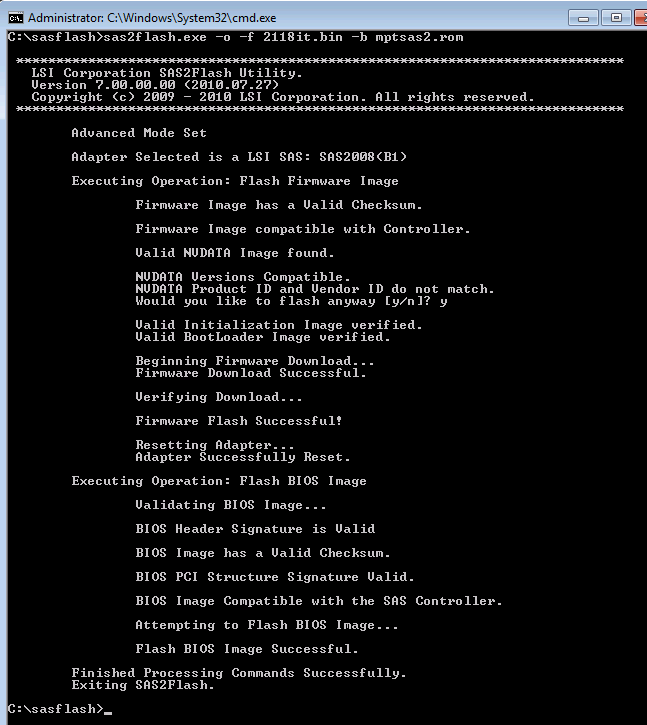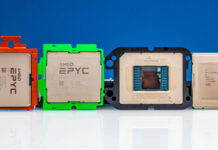Following theIntel SASUC8I and LSI SAS3081E-R 1068e Based RAID Controller Review which featured a LSI 1068e based Intel SASUC8I I have started to take a look at LSI SAS 2008 based controllers. One such controller I have been working with is based on the Supermicro X8SI6-F which has an onboard LSI SAS 2008 8-port SAS2 controller. This onboard controller is essentially a LSI 9211-8i RAID controller shipping with IR firmware. Since LSI’s IR firmware on the lower-end cards like Intel SASUC8I, LSI SAS8081E-R, and the 9211-8i is limited to RAID 0 and RAID 1, the IT firmware makes a lot of sense for those users looking to use OpenSolaris, Linux, or Windows Home Server to manage software RAID and redundancy.
The first step toward flashing the Supermicro X8SI6-F with LSI IT firmware is getting the firmware. For this, one can navigate to the LSI 9211-8i’s page and choose the appropriate package in the downloads section. Since I was flashing from a Windows 7 x64 Professional environment, I used the “Package for Firmware and BIOS Upgrade on MSDOS and Windows” on the downloads page dated 11 August 2010 and extracted three files to a directory C:\sasflash

The 2118.bin is the firmware (the original sasflash used .fw files for firmware), mptsas2.rom is the BIOS file and sas2flash.exe is the LSI flash utility. I did try flashing the controller using the same sasflash.exe application I used for the Intel SASUC8I to no avail. One needs the new sas2flash.exe application and like any flash utility, to make this all work one needs to run cmd.exe as Administrator in Windows 7.
As was discovered trying to flash the Intel SASUC8I using LSI firmware, my initial attempts at flashing did yield an error due to the fact that the Supermciro X8SI6-F’s onboard controller has a Supermicro vendor name instead of a LSI vendor name. Again all one needs to do is add a “-o” to the sasflash command line and everything works perfectly. Here is what the command and utility output looks like once the “-o” switch is added (the command for reference for the LSI Windows sasflash.exe utilityflashing both the firmware and BIOS is: “sas2flash -o -f 2118it.bin -b mptsas2.rom”):

That is all there is to it! I confirmed shortly thereafter that the onboard SAS2 controller does work with the HP SAS Expander when the onboard controller uses the IT firmware. Interestingly, with this motherboard plus a HP SAS Expander, there is enough connectivity for 40 drives+ (6x on the Intel onboard controller, 4x on the onboard LSI SAS 2008 controller, and 32x on the HP SAS Expander.)
[Ed. It seems like LSI decided to change the ability to flash IT firmware over IR firmware in later sas2flash.exe versions. See the LSI knowledgebase article if you have issues.]




Why not use the RAID firmware and just use RAID 1 or RAID 0?
For many storage related operating systems/ file systems there are built in tools to handle redundancy and provide RAID or RAID like functions. For example, using a ZFS enabled operating system and RAID-Z2 or RAID-Z3 is oftentimes desirable. The LSI controllers in IT mode are really great for these applications alone, in combination with other controllers, and in combination with SAS expanders.
RAID 0 is generally not something that is advisable for large arrays except in a minority of applications where complete failure/ data loss is acceptable.
Is there any advantage (either cost or performance) to have the LSI SAS 2008 on the motherboard?
/or/ simply purchase a LSI 9211-8i and add to an existing system.
That is something I will likely go over in the Supermicro X8SI6-F review. I have been testing the X8SI6-F and the LSI 9211-8i in the same system, just moving the SFF-8087 cables between the two. Thus far I have been seeing virtually the same performance from both solutions.
Cost wise, there is. The X8SI6-F costs as much as (or less than) a LSI 9211-8i and a dual port Intel NIC combined. That basically makes the motherboard and KVM-over-IP “free”.
The major drawback is the fact that if the controller fails, with an onboard controller it may be harder to replace since then one would have to add a 9211-8i add-in card, or in the absence of an open PCIe slot replace the motherboard. The X8SI6-F does have one less PCIe slot than the X8SIL-F, for example, making it more likely to have the slots full.
Hi Patrick,
have an issue with configuring RAID on a H8DG6 post flashing the it fw. My controller shows a NVDATA not matching – flashing the IR fw gets rid of this. Does one need a fitting nvdata image as well?
Thanks,
Florian
Florian, did you use the -o switch for advanced mode? Here is the LSI SAS2Flash manual (see section 5.4 and 5.4.2)
Hi Patrick,
yes, the flashing works just fine with -o (without it, it doesn’t). The problem is that I can’t install RAID volumes afterwards (the option isn’t even shown, neither in the BIOS util nor in the MegaRAID mgmt sw. I assume this is due to the “non-compatible nvdata”, which is shown in the controller properties page instead of the nvdata version.
Anyway, I only did want a RAID-1 anyway, which works with the IR fw, so I am probably fine.
Thanks,
FloriaN
The IT firmware is used basically to turn the controller into a HBA (SAS Expander aware). When in IT mode, you are basically disabling the onboard RAID functions.
That is probably the reason then – thought the IT fw was actually enabling the missing RAID modes. Got that wrong therefore, I guess. Thanks for the insight!
Florian
Hi Patrick,
could you send me ver 7.00 of the sas2flash. I have the latest one (8.00) and they disabled the possibility of flashing IT over IR version (even with -o option).
Finally I was able to flash IT over IR version.
Before flasihing you need to erase the old firmware using the following command:
sas2flash -o -e 7
Finally I’ve managed to flash IT over IR version. You need to erase the flash using the command:
sas2flsh -o -e 7
Good to hear you got that working.
Can flash to IT mode, just got the board.
using sas2flash ver. 9
sas2flash -o -f 2118it.bin -b mptsas2.rom
ERROR: Cannot Flash IT Firmware over IR Firmware!
Trying to clear firmware:
sas2flash -o -e 7
Erase Flash Command not Supported on this platform.
Running on Windows Server 2008 R2, try both sas2flash x86 & x64 (version 9) same behavior…
PLEASE help
Madburg: If you look at the LSI knowledge base article mentioned at the bottom of the article which covers this for newer firmware versions it says: “This process can only be done in DOS.”
What’s the difference between this LSI Firmware, and the IT Firmware that Supermicro offers on their site?
Also, are there any performance issues due to the switch? I was Googling the 9211-8i and ESXi, and came across this: http://communities.vmware.com/message/1689425
I’m assuming that wouldn’t come into play here, as it’s IT mode, but just wondering about any other issues
Hi,
I must warn everybody that flashing the official LSI firmware and bios in the X8SI6-F makes it unusable with the Supermicro Chassis backplane (I tested 836-EL2).
The controller will not recognize the backplane properly and starts giving errors.
The only solution back is to flash the original (and probably modded) firmware. Supermicro has released version 9 of the firmware recently.
Paul: Good point. Supermicro does modify firmware as we have seen with add-on controllers and their SAS expander backplanes. I just tried flashing the onboard LSI controller and it does work with the HP SAS expander.
Paul: I have not found the location of the V9 SuperMicro Firmware, all I have found is V7.
Has anyone found this SuperMicro customized firmware ?
v9 IT firmware for LSI 2008 based Supermicro controllers:
ftp://ftp.supermicro.com/driver/SAS/LSI/2008/IT/Firmware/
Is there any known IT firmware for 2108 based controllers?
I would like to put the on-board controller in a new Supermicro Server 1026T-6RFT+ in IT mode.
> Is there any known IT firmware for 2108 based controllers?
> I would like to put the on-board controller in a new Supermicro
> Server 1026T-6RFT+ in IT mode.
I second this. I need IT or IR firmware for the same exact board/chipset.
>>Chip Schweiss
>>Is there any known IT firmware for 2108 based controllers?
>>I would like to put the on-board controller in a new Supermicro Server 1026T-6RFT+ in IT >>mode.
There is no way to make HBA from LSI 2108 based controller.
This has been a great thread, but does any know of IT firmware for the LSI 1078 based cards?
I too had the issue where the flash util refused to flash over the existing firmware.
I used the sas2flash -o -e 7 line posted in the comments and it worked. BUT it erased the WWN number from the card giving me an error every boot about the SAS address not being programmed.
SO DO NOT USE sas2flash -o -e 7. Instead use sas2flash -o -e 6. That will erase the flash but it won’t erase the manufacturing area which contains the WWN.
If you do erase the wwn. You’ll need to reenter it using sas2flash -o -sasadd (wwn number). Usually this number is on a sticker somewhere on the card or motherboard.
If you can’t find it. You can make up an 8 byte hex number. A WWN is like an ethernet mac address. Every card in the system needs to have a unique one.
As far as you know, would this same technique work with an HP H222 (which is apparently an LSI 9205-4i4e)?
Thanks.
I managed to flash the onboard card to IT mode on my x8si6-f no problems, but now the onboard card reports being connected to PCI slot ‘FF’ – which according to the help in the sas configuration utility means that it’s being assigned an invalid PCI slot by the motherboard BIOS.
I’ve googled the problem with very little result – anyone have any suggestions for how I can manually assign a PCI slot number to the onboard card?
fixed it – had to download the supermicro branded firmware from the supermicro website. the link on the motherboard page is broken, but if you dig around in their ftp site it’s not at all hard to find. :-)